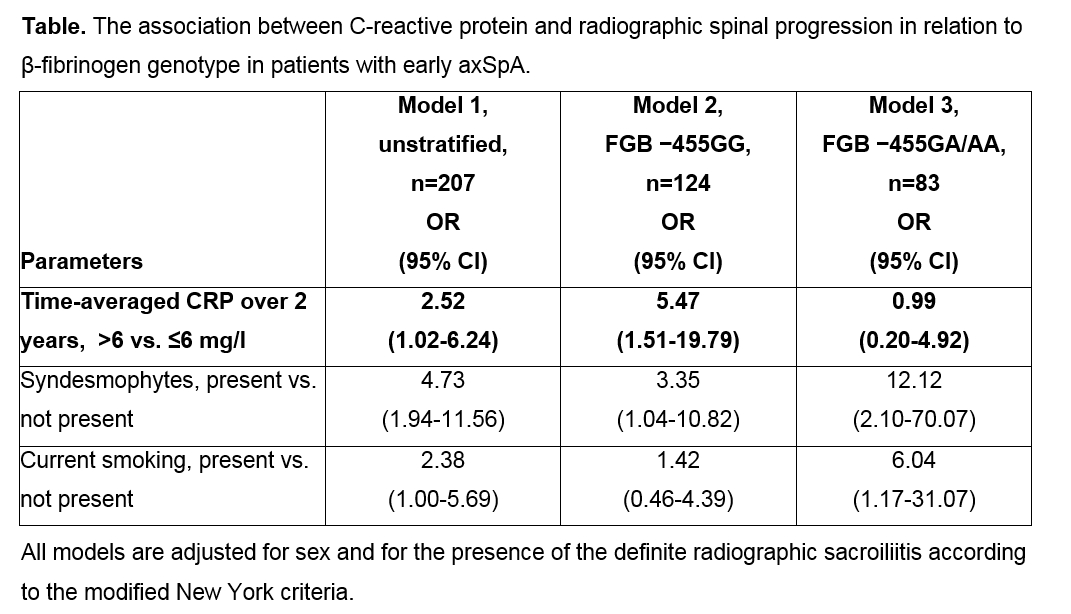Session Information
Date: Sunday, November 5, 2017
Title: Spondyloarthropathies and Psoriatic Arthritis – Clinical Aspects and Treatment Poster I
Session Type: ACR Poster Session A
Session Time: 9:00AM-11:00AM
Background/Purpose:
It has been shown in the past that inflammatory activity (i.e., elevated C-reactive protein) predicts radiographic spinal progression in patients with axial spondyloarthritis (axSpA). Fibrinogen and factor 13 genotypes have been recently identified as factors modifying inflammatory response due to differences in the properties of the fibrin network related to particular genotype constellations [1].
The objective of the current study was to investigate the association between α-fibrinogen (FGA), β-fibrinogen (FGB) and factor XIII A-subunit (F13A) genotypes with the level of CRP and radiographic spinal progression over 2 years in patients with early (up to 10 years symptom duration) axial SpA.
Methods:
Altogether 207 patients with early axial SpA from the German Spondyloarthritis Inception Cohort (GESPIC) were included. Clinical data and CRP level were collected at baseline and every 6 months thereafter. A time-averaged CRP level over 2 years (up to 5 time-points) was calculated. Structural damage in the spine was assessed on spinal radiographs at baseline and after two years according to the modified Stoke Ankylosing Spondylitis Spine Score (mSASSS). Significant radiographic spinal progression was defined as the worsening of the mSASSS by ≥2 points over two years. FGB −455G>A (rs1800790), FGA T312A (rs6050) and F13A V34L (rs5985) genotypes were determined with available samples using allele-specific primer pairs.
Results:
No clear association between studied genotypes and the time-averaged CRP or radiographic spinal progression could be found. However, the effect of CRP in the predictive model for radiographic spinal progression was strongly dependent on FGB genotype (table): the odds ratio (OR) for the elevated time-averaged CRP as a predictor of the mSASSS worsening by ≥2 points over two years was 5.47 (95%CI 1.51-19.79) in FGB −455GG (wild-type) carriers, while there was no such effect of CRP in carriers of the alternative (A) allele, OR=0.99 (95%CI 0.20-4.92). Interestingly, this effect modification was dependent also on F13A genotype: in carriers of the wild-type genotypes of both FGB (−455GG) and F13A (34VV), n=65, the OR for the elevated CRP as a predictor of radiographic spinal progression was 10.8 (95%CI 1.07-108.0), while alternative allele carriers (F13A 34L) showed a weak and non-significant association of CRP with radiographic spinal progression even in the presence of the wild-type FGB genotype (n=59): OR=2.01 (95%CI 0.34-12.04). F13A itself as well as FGA genotypes showed no effect-modifying effects on CRP.
Conclusion:
The predictive value of CRP regarding radiographic spinal progression seems to be dependent on FGB and F13A genotypes. This might also suggest that CRP is not a good indicator of inflammation in individuals with a specific genetic background.
References:
1. Hoppe B, et al. Ann Rheum Dis. 2012 Jul; 71(7):1163-1169.
To cite this abstract in AMA style:
Poddubnyy D, Schwedler C, Haibel H, Rudwaleit M, Sieper J, Hoppe B. The Value of C-Reactive Protein As a Predictor of Radiographic Spinal Progression Is Strongly Dependent on β-Fibrinogen and Factor XIII a-Subunit Genotypes in Patients with Axial Spondyloarthritis [abstract]. Arthritis Rheumatol. 2017; 69 (suppl 10). https://acrabstracts.org/abstract/the-value-of-c-reactive-protein-as-a-predictor-of-radiographic-spinal-progression-is-strongly-dependent-on-%ce%b2-fibrinogen-and-factor-xiii-a-subunit-genotypes-in-patients-with-axial-spondyloarthriti/. Accessed .« Back to 2017 ACR/ARHP Annual Meeting
ACR Meeting Abstracts - https://acrabstracts.org/abstract/the-value-of-c-reactive-protein-as-a-predictor-of-radiographic-spinal-progression-is-strongly-dependent-on-%ce%b2-fibrinogen-and-factor-xiii-a-subunit-genotypes-in-patients-with-axial-spondyloarthriti/

